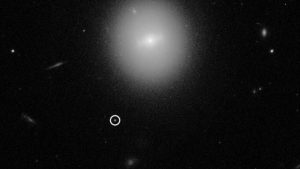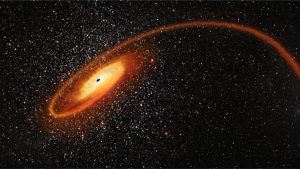
Hubble finds good evidence for an intermediate-sized black hole in a distant star cluster on the outskirts of another galaxy, and the element neon can eat so many electrons at the core that it can cause massive stars to collapse.
Links
Hubble finds mid-sized black hole
- Hubble finds best evidence for elusive mid-sized black hole (Hubble Space Telescope)
- NASA: Hubble finds best evidence for elusive mid-sized black hole (Phys.org)
- Images: Hubble finds best evidence for elusive mid-sized black hole (Hubblesite)
Star Collapse caused by Neon
Transcript
This is the Daily Space for today, Thursday, April 2, 2020.
Welcome to the Daily Space, I am your host, Dr Pamela Gay, and I am here to put science in your brain. Most Mondays through Fridays either I or my co-host Annie Wilson will be here, bringing you a quick run down of all that is new in space and astronomy.
It has been 33 days since I last left my yard, and my bad angel would like to let you know that it is spring, and it is glorious out there, and if we don’t shelter in place and flatten that curve, none of us get to go to the garden shop to get all the things we need to keep the bugs away and make observing from or balconies, patios, and gardens the pleasure it should be. And there is so much more. Folks, I know it’s getting hard, but it’s important we all stay put and find reasons to socialize online instead of straying out into the real world.
Here at the Daily Space, we are normally happy to travel with you to the gym, the laundromat, and all the other weird and random places we go to in our normal lives. Right now, I hope we’re coming to you as you hangout in your favorite chair, as you do dishes in your own kitchen, or as you hangout in that awesome new blanket fort you and your cat have constructed with sofa cushions and grandma’s afghan.
Stay home people. Stay home and let’s learn some science.

Today, I am pleased to share that astronomers have finally, and pretty incontrovertibly, found an intermediate mass black hole; an object too big to be the result of a single giant star dying, and too small to have formed at the heart of a galaxy. This new object, named 3XMM J2150022.4-055108 is estimated to be 50,000 times bigger than our Sun, which may seem big, but for perspective, our Milky Way’s central black hole is 4.1 million solar masses.
Since intermediate black holes can’t be part of a binary star system, and don’t have massive galaxies pointing at their location, trying to find them has been a challenge. Black holes don’t give off any light, and the only ways we can pinpoint their locations are to look for the tell tale light of a surrounding disk of material, catch the high energy flash of something falling past their event horizon, or get lucky and see them gravitationally lensing the light of a more distant object. So far, gravitational lensing surveys have failed us, and constantly bright accretion disks haven’t been a thing we could find. Coming to the rescue was an X-Ray flash caught by Chandra X-Ray observatory and followed up on with the Hubble Space Telescope. The actual image of the area where this object is located is kind of boring: it’s nothing more than a barely resolved star cluster hanging out in the outskirts of a not too distant galaxy. Amusingly, the boringness of the actual image seems to have inspired Hubble Europe, HEIC, and Hubble USA, STScI, to each create their own art’s renditions of this system, with the European graphic being, in my opinion, a truly magnificent graphic.

This flare of X-Ray that is consistent with a star being shredded on an event horizon in a star cluster and this is exactly what folks would expect of an intermediate blackhole. We can’t say exactly how you form one of these mid-sized relativity machines, but we suspect it is either through the chaotic processes that lead to the formations of dwarf galaxies, or through the collisions and mergers of many objects in dense environments. The distant star cluster where this object was seen could easily be a dwarf galaxy caught up and shredded a bit by the galaxy it now orbits.
This work is published in a new paper in the Astrophysical Journal Letters led by Dacheng Lin of the University of New Hampshire. My favorite part of this story is this black hole was only discovered because Chandra was pointed in exactly the right direction when the BH ate a star or something that flared up in X Rays as it was destroyed. For all we know, the myriad dwarf galaxies around our galaxy could be rich in these same kinds of intermediate mass objects, but we haven’t been able to find them because they just haven’t been eating while we’ve been looking.

Understanding how stars die, and how they form these elusive massive objects has been a favourite task since we began to understand the nuclear processes that drive stars and quantum processes that hold up their degenerate carcasses just 100 years ago. One of our biggest struggles has been in sorting out what happens with stars in the 8-10 solar mass range that may end up forming white dwarfs, but may also explode as supernovae and become neutron stars. Exactly which of these two outcomes occurs is a complex problem that includes understanding how much mass is lost through stellar winds, and sorting out all the nuclear fusion processes in the stellar cores. At this mass, the last stage of a star’s evolution includes the formation of a core rich in Oxygen, Neon, and Magnesium. At this point, the star is supported through a combination of light pressure from burning shells of hydrogen and helium, and by electron pressure in the core. In our traditional way of thinking, the ultimate fate of the star is determined by how much mass the star losses while undergoing this final burning.

In new research from the Kavali institute, scientists postulate that the neon and magnesium in the core can undergo electron capture, grabbing up free electrons and converting them into neutrons, neutrinos, and heat. This drives the oxygen to ignite, and radically decreases the electron pressure supporting the core. When this happens, the system … well a supernova is now it’s destiny and a neutron star is certain.
I’d like to point out that this story came with what is the weirdest illustration I have ever seen. It is meant to depict the electrons getting gobbled up, but…
<———————>
As part of helping keep us all occupied in these really weird times, we’re going to be hosting a lot of additional content on our Twitch channel, and we want to remind you that CosmoQuest has an active community on Discord where you can talk science and even find other people to join you in playing some online games. You can find links to everything that is going on at CosmoQuest.org.
Thank you all for listening. Today’s script was written by Pamela Gay, and the Daily Space is produced by Susie Murph. The Daily Space is a product of the Planetary Science Institute, a 501(c)3 non profit dedicated to exploring our Solar System and beyond. We are here thanks to the generous contributions of people like you. The best way you can support us is through Patreon.com/cosmoquestx Like us? Please share us! You never know whose life you can change by adding a daily dose of science.


 We record most shows live, on Twitch. Follow us today to get alerts when we go live.
We record most shows live, on Twitch. Follow us today to get alerts when we go live.